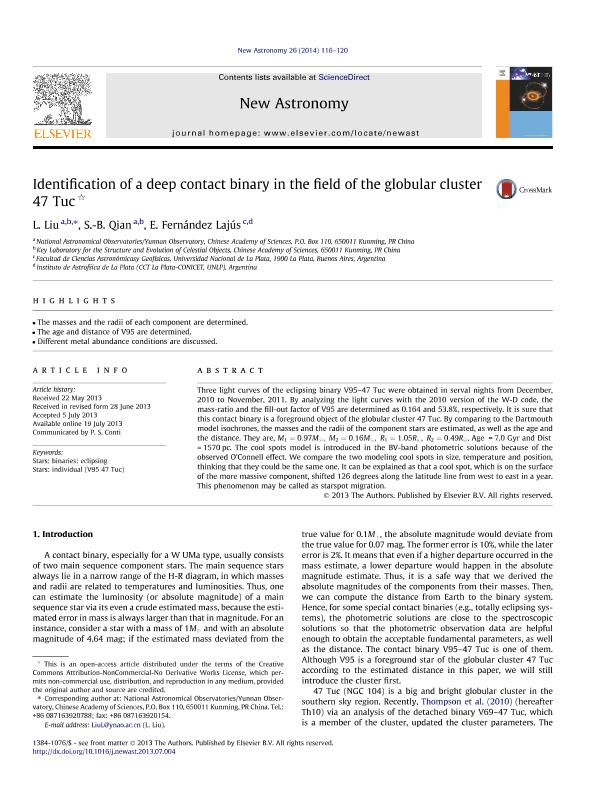Mostrar el registro sencillo del ítem
dc.contributor.author
Liu L.
dc.contributor.author
Qian, S. B.
dc.contributor.author
Fernandez Lajus, Eduardo Eusebio

dc.date.available
2017-01-03T18:05:47Z
dc.date.issued
2014-01
dc.identifier.citation
Liu L.; Qian, S. B.; Fernandez Lajus, Eduardo Eusebio; Identification of a deep contact binary in the field of the globular cluster 47 Tuc; Elsevier Science; New Astronomy; 26; 1; 1-2014; 116-120
dc.identifier.issn
1384-1076
dc.identifier.uri
http://hdl.handle.net/11336/10763
dc.description.abstract
Three light curves of the eclipsing binary V95–47 Tuc were obtained in serval nights from December, 2010 to November, 2011. By analyzing the light curves with the 2010 version of the W-D code, the mass-ratio and the fill-out factor of V95 are determined as 0.164 and 53.8%, respectively. It is sure that this contact binary is a foreground object of the globular cluster 47 Tuc. By comparing to the Dartmouth model isochrones, the masses and the radii of the component stars are estimated, as well as the age and the distance. They are, M1 ¼ 0:97M; M2 ¼ 0:16M; R1 ¼ 1:05R; R2 ¼ 0:49R, Age = 7.0 Gyr and Dist = 1570 pc. The cool spots model is introduced in the BV-band photometric solutions because of the observed O’Connell effect. We compare the two modeling cool spots in size, temperature and position, thinking that they could be the same one. It can be explained as that a cool spot, which is on the surface of the more massive component, shifted 126 degrees along the latitude line from west to east in a year. This phenomenon may be called as starspot migration.
dc.format
application/pdf
dc.language.iso
eng
dc.publisher
Elsevier Science

dc.rights
info:eu-repo/semantics/openAccess
dc.rights.uri
https://creativecommons.org/licenses/by-nc-sa/2.5/ar/
dc.subject
Eclipsing
dc.subject
V95 47 Tuc
dc.subject.classification
Astronomía

dc.subject.classification
Ciencias Físicas

dc.subject.classification
CIENCIAS NATURALES Y EXACTAS

dc.title
Identification of a deep contact binary in the field of the globular cluster 47 Tuc
dc.type
info:eu-repo/semantics/article
dc.type
info:ar-repo/semantics/artículo
dc.type
info:eu-repo/semantics/publishedVersion
dc.date.updated
2017-01-02T18:36:37Z
dc.journal.volume
26
dc.journal.number
1
dc.journal.pagination
116-120
dc.journal.pais
Países Bajos

dc.journal.ciudad
Amsterdam
dc.description.fil
Fil: Liu L.. Chinese Academy Of Sciences; República de China
dc.description.fil
Fil: Qian, S. B.. Chinese Academy Of Sciences; República de China
dc.description.fil
Fil: Fernandez Lajus, Eduardo Eusebio. Consejo Nacional de Investigaciones Científicas y Técnicas. Centro Científico Tecnológico la Plata. Instituto de Astrofísica de la Plata; Argentina. Universidad Nacional de la Plata. Facultad de Ciencias Astronómicas y Geofísicas; Argentina
dc.journal.title
New Astronomy

dc.relation.alternativeid
info:eu-repo/semantics/altIdentifier/doi/http://dx.doi.org/10.1016/j.newast.2013.07.004
dc.relation.alternativeid
info:eu-repo/semantics/altIdentifier/url/http://www.sciencedirect.com/science/article/pii/S138410761300081X
Archivos asociados
